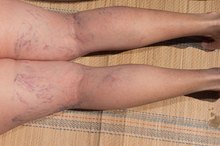What does fact checked mean?
At Healthfully, we strive to deliver objective content that is accurate and up-to-date. Our team periodically reviews articles in order to ensure content quality. The sources cited below consist of evidence from peer-reviewed journals, prominent medical organizations, academic associations, and government data.
The information contained on this site is for informational purposes only, and should not be used as a substitute for the advice of a professional health care provider. Please check with the appropriate physician regarding health questions and concerns. Although we strive to deliver accurate and up-to-date information, no guarantee to that effect is made.
Symptoms of a Blood Clot in Groin Area
A blood clot can be a very serious condition, especially if a clot dislodges or travels through a vein or artery to the lungs, brain or heart. Blood clots can form anywhere from clusters of blood cells that stick and clump together, and are most commonly found in the lower extremities, the groin area, and the neck. Learning to recognize the symptoms of a blood clot in the groin area may help individuals seek immediate treatment and prevent complications. Clots are most common in older individuals, and those who have recently undergone surgery.
Swelling
Blood clots often cause swelling in the extremity closest to the clot location 1. In the case of a blood clot in the groin, and individual might notice swelling of the thigh or calf. In many cases, this swelling may not be very noticeable, considering the location of the clot, but for others the swelling may be extreme as the interruption of blood flow through the extremity is compromised, leading to an accumulation of fluids called edema.
Reddened Skin
What Are The Symptoms of Blood Clots in The Leg?
Learn More
An area of reddened skin may be noticed in the groin, caused by the perfusion of blood that may collect in nearby tissues as the clot interferes with normal blood flow as well as the growth and development of cell structures in and around the groin area.
Pain
Many people suffering from a blood clot in the groin may feel tenderness in the localized area, or even in other parts of the leg. Bruising is not usually apparent. Soreness may be mild or moderate, as a result of gentle pressure on the inside thigh area or other parts of the leg where skin is more tender and sensitive to pressure. Many people experience pain in the calf and foot of the affected leg.
- Many people suffering from a blood clot in the groin may feel tenderness in the localized area, or even in other parts of the leg.
- Soreness may be mild or moderate, as a result of gentle pressure on the inside thigh area or other parts of the leg where skin is more tender and sensitive to pressure.
Warmth
DVT Symptoms in the Legs
Learn More
The accumulation of blood in any single area may cause surrounding tissues to grow warm. Sometimes, swelling is also present. People with a groin area blood clot may often feel an isolated warm spot somewhere on the leg.
Additional Symptoms
Additional symptoms of a blood clot in the groin may include (if the clot or a piece of the clot has broken off) a feeling of dizziness and anxiety. Pain may be more noticeable or disappear completely as the blood clot travels through the vein or artery. Deep vein thrombosis is the most commonly experienced type of blood clot among those who sit or stand for long periods of time, with numbness or tingling often felt in the leg or both legs.
Related Articles
References
- Guide to Preventing and Treating Blood Clots
- Mayo Clinic
- American Society of Hematology. Blood Clots.
- Litvinov RI, Weisel JW. What Is the Biological and Clinical Relevance of Fibrin?. Semin Thromb Hemost. 2016;42(4):333-43. doi:10.1055/s-0036-1571342
- American Heart Association. Understand Your Risk for Excessive Blood Clotting.
- Adivitiya, Khasa YP. The evolution of recombinant thrombolytics: Current status and future directions. Bioengineered. 2017;8(4):331-358. doi:10.1080/21655979.2016.1229718
- Fields JM, Davis J, Girson L, et al. Transthoracic Echocardiography For Diagnosing Pulmonary Embolism: A Systematic Review And Meta-Analysis. J Am Soc Echocardiogr 2017; 30:714. doi:10.1016/j.echo.2017.03.004
- Gibson NS, Schellong SM, Kheir DY, et al. Safety And Sensitivity Of Two Ultrasound Strategies In Patients With Clinically Suspected Deep Venous Thrombosis: A Prospective Management Study. J Thromb Haemost 2009; 7:2035. doi:10.1111/j.1538-7836.2009.03635.x
- National Blood Clot Alliance. Signs and Symptoms of Blood Clots.
- Weitz JI, Fredenburgh JC, Eikelboom JW. A Test In Context: D-Dimer. J Am Coll Cardiol 2017; 70:2411. doi:10.1016/j.jacc.2017.09.024
Writer Bio
Denise Stern is an experienced freelance writer and editor. She has written professionally for more than seven years. Stern regularly provides content for health-related and elder-care websites and has an associate and specialized business degree in health information management and technology.







